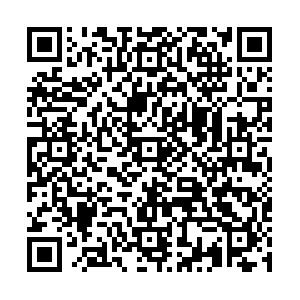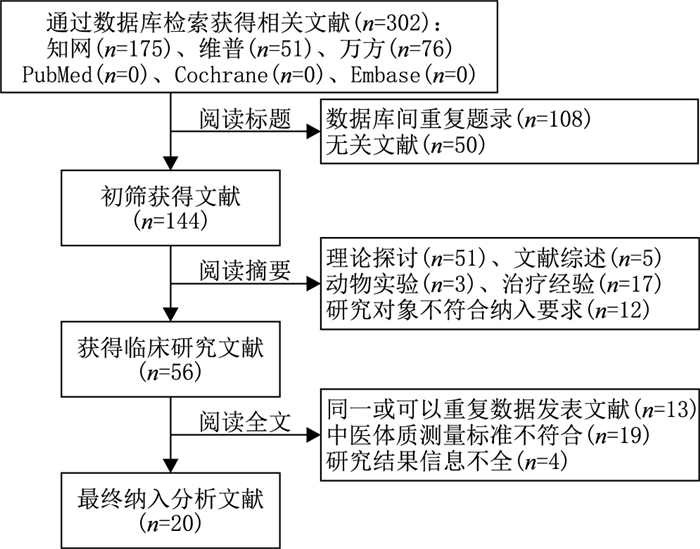Correlation between TCM constitution and polycystic ovary syndrome: a meta-analysis
-
摘要:
目的 总结中医(TCM)体质类型和多囊卵巢综合征(PCOS)相关研究现状,探讨PCOS患者的中医体质分布规律,为PCOS的中医药防治提供循证医学证据。 方法 检索中国知网、维普、万方、PubMed、Cochrane、Embase数据库,纳入所有PCOS中医体质类型的临床研究文献。采用Stata 16.0进行meta分析,并分别以率和比值比及其95%可信区间表达效应值。 结果 共纳入20项研究,累计样本量4 928例。结果显示:痰湿质、阳虚质、气郁质和气虚质占PCOS患者的比例分别为15.8%、14.1%、12.5%和12.1%。按地区进行亚组分析显示华中痰湿质、阳虚质和特禀质比例最高,华北血瘀质和气虚质最高,华东气郁质和湿热质最高,华南和华西则分别以平和质和阴虚质为主。PCOS患者与一般人群体质类型比较显示,痰湿质(OR=1.871, 95% CI:1.109~3.156,P=0.019), 平和质(OR=0.313,95% CI:0.208~0.472,P < 0.001),其余体质类型差异无统计学意义。 结论 痰湿质、阳虚质、气郁质和气虚质是PCOS患者的主要体质类型;痰湿质为PCOS的危险因素,平和质为PCOS的保护因素。 Abstract:Objective To summarise the research status of traditional Chinese medicine (TCM) constitution types and polycystic ovary syndrome (PCOS), and to explore the distribution of TCM constitution of PCOS patients, so as to provide evidence-based medical evidence for TCM prevention and treatment of PCOS. Methods The databases of CNKI, CQVIP, Wanfang Data, PubMed, Cochrane and Embase were searched, and all clinical research documents of TCM constitution types of PCOS were retrieved. Meta-analysis was carried out with Stata 16.0, and the effect values were expressed in terms of rate, ratio and 95% confidence interval. Results Twenty studies were included with 4 928 individuals. The results showed that phlegm-dampness, yang deficiency, qi stagnation and qi deficiency accounted for 15.8%, 14.1%, 12.5% and 12.1% of PCOS patients, respectively. Subgroup analysis by region showed that the proportion of phlegm-dampness, yang deficiency and special was the highest in Central China, blood stasis constitutions and qi deficiency were the highest in North China, qi stagnation and damp-heat constitutions were the highest in East China, and balanced constitution and yin deficiency were the highest in South China and West China. The comparison of constitution types between PCOS patients and the general population showed that phlegm dampness (OR=1.871, 95% CI: 1.109-3.156, P=0.019) and peace (OR=0.313, 95% CI: 0.208-0.472, P < 0.001). There was no significant difference in other constitution types. Conclusion Phlegm-dampness, yang deficiency, qi stagnation and qi deficiency are the main constitution types of PCOS patients. Phlegm-dampness is a risk factor of PCOS, and balanced constitution is a protective factor of PCOS. -
表 1 纳入研究的基本特征及质量评分表
Table 1. Basic characteristics and quality evaluation table of the included studies
序号 纳入研究 时间 研究地区 研究类型 样本量(例) 年龄(岁) 质量评价(分) 1 陈俊杰[3]2011 2010年3月—2010年12月 四川 横断面 132 16~37 7 2 邹晴燕[4]2011 2009年9月—2010年9月 广西南宁 横断面 103 19~37 6 3 潘丽萍[5]2012 2011年1月—2012年1月 广东 横断面 256 18~43 7 4 李瑞丽等[6]2013 2011年6月—2012.10月 河南 横断面 980 18~40 8 5 赵铮[7]2013 2012年1月—2013年1月 广西壮族自治区 病例对照 90 不详 6 6 朱志琴等[8]2014 2011年6月—2012年12月 广东 病例对照 236 18~39 6 7 李欢欢[9]2014 2012年2月—2013年11月 河南 病例对照 88 18~40 6 8 郭丽等[10]2015 2013年10月—2014年7月 四川 病例对照 40 24~37 3 9 徐原哲[11]2015 2013年9月—2014年12月 山东 病例对照 108 18~38 5 10 柯欣[12]2015 2014年6月—2015年1月 四川 横断面 150 16~37 6 11 王昕等[13]2016 2014年11月—2015年6月 山东 病例对照 266 18~38 7 12 胥威风[14]2016 2015年4月—2016年2月 河南 病例对照 113 19~35 6 13 丁春丽等[15]2016 2013年1月—2015年2月 黑龙江 横断面 390 16~40 8 14 朱鸿秋等[16]2017 2015年4月—2016年2月 四川 病例对照 203 不详 5 15 张丽[17]2018 2015年1月—2018年1月 江苏 病例对照 200 18~38 6 16 吴思宁等[18]2018 2016年3月—2018年2月 广东 病例对照 60 23~36 6 17 文慧华[19]2018 2016年7月—2017年6月 广东 横断面 80 17~45 6 18 贾淑淋[20]2018 2016年5月—2018年2月 四川 病例对照 187 17~37 5 19 孙红涛[21]2019 2017年6月—2018年12月 宁夏 横断面 221 18~35 8 20 朱晨颖[22]2019 2016年1月—2018年12月 黑龙江 病例对照 1025 20~40 5 表 2 PCOS患者不同体质类型比率的meta分析结果
Table 2. Meta-analysis results of the ratio of PCOS patients with different constitution types
体质类型 纳入研究数量(项) 占总人数比例(%) 95% CI Q值 I2 (%) P值 痰湿质 20 15.8 12.8~18.7 204.57 90.7 < 0.001 阳虚质 20 14.1 10.8~17.4 346.89 94.5 < 0.001 气郁质 20 12.5 10.4~14.7 114.20 83.4 < 0.001 气虚质 20 12.1 8.5~15.7 388.03 95.1 < 0.001 湿热质 20 11.5 9.5~13.5 111.61 83.0 < 0.001 平和质 18 10.6 7.8~13.5 314.68 94.6 < 0.001 阴虚质 20 9.1 7.1~11.1 130.37 85.4 < 0.001 血瘀质 20 8.5 5.9~11.2 276.89 93.1 < 0.001 特禀质 15 3.6 2.0~5.2 150.53 90.7 < 0.001 表 3 PCOS患者与一般人群体质类型比较的meta分析
Table 3. Meta-analysis of comparison of physical types between PCOS patients and the general population
体质类型 OR值 95% CI I2(%) P值 痰湿质 1.871 1.109~3.156 0 0.019 阳虚质 0.827 0.530~1.290 0 0.402 气郁质 1.471 0.935~2.313 29.3 0.095 气虚质 0.953 0.595~1.527 0 0.843 湿热质 1.434 0.925~2.224 0 0.107 平和质 0.313 0.208~0.472 0 < 0.001 阴虚质 1.293 0.764~2.185 0 0.338 血瘀质 1.444 0.750~2.781 0 0.272 特禀质 1.614 0.654~3.981 0 0.299 -
[1] WEISS N S, KOSTOVA E, NAHUIS M, et al. Gonadotrophins for ovulation induction in women with polycystic ovary syndrome[J]. Cochrane Db SystRev, 2019, 1(1): cd010290. DOI: 10.1002/14651858.CD010290.pub3. [2] 吴长汶, 朱龙, 唐娜娜, 等. 基于治未病思想指导下的疾病风险预警系统研究[J]. 中华中医药杂志, 2017, 32(7): 2848-2852. https://www.cnki.com.cn/Article/CJFDTOTAL-BXYY201707004.htmWU C W, ZHU L, TANG N N, et al. Research on disease risk pre-warning System Based on the Thought of preventing disease[J]. China journal of traditional Chinese medicine, 2017, 32(7): 2848-2852. https://www.cnki.com.cn/Article/CJFDTOTAL-BXYY201707004.htm [3] 陈俊杰. 多囊卵巢综合征临床表现与体质类型之间的分布特点初探[D]. 成都: 成都中医药大学, 2011.HE J J. Clinical manifestations of polycystic ovary syndrome and the distribution characteristics of the constitution type[D]. Chengdu: Chengdu University of Traditional ChineseMedicine, 2011. [4] 邹晴燕. 多囊卵巢综合征代谢特征与中医体质类型的相关性研究[D]. 南宁: 广西中医药大学, 2011.ZOU Q Y. Study on metabolic characteristics of polycystic ovary syndrome and TCM constitution type[D]. Nanning: Guangxi University of Traditional Chinese Medicine, 2011. [5] 潘丽萍. 多囊卵巢综合征的中医体质辨识及证侯的相关研究[D]. 广州: 广州中医药大学, 2012.PAN L P. Identification of Traditional Chinese medicine constitution and syndrome of polycystic ovary syndrome[D]. Guangzhou: Guangzhou University of Traditional Chinese Medicine, 2012. [6] 李瑞丽, 傅金英, 杜蕾, 等. 多囊卵巢综合征患者中医体质分布特征调查[J]. 中医学报, 2013, 28(8): 1192-1193. https://www.cnki.com.cn/Article/CJFDTOTAL-HNZK201308044.htmLI R L, FU J Y, DU L, et al. Investigation on characteristics of TCM constitution distribution in patients with polycystic ovary syndrome[J]. Journal of traditional Chinese medicine, 2013, 28(8): 1192-1193. https://www.cnki.com.cn/Article/CJFDTOTAL-HNZK201308044.htm [7] 赵铮. 多囊卵巢综合征与中医痰湿体质的相关性研究[D]. 南宁: 广西中医药大学, 2013.ZHAO Z. Study on the relationship between polycystic ovary syndrome and phlegm-dampness constitution in Traditional Chinese medicine[D]. Nanning: Guangxi University of Traditional Chinese Medicine, 2013. [8] 朱志琴, 郝元涛, 陈爱兰, 等. 多囊卵巢综合征患者中医体质类型分布研究[J]. 中国妇幼保健, 2014, 29(15): 2389-2391. https://www.cnki.com.cn/Article/CJFDTOTAL-ZFYB201415036.htmZHU Z Q, HAO Y T, Chen A l, et al. Study on the distribution of traditional Chinese medicine constitution types in patients with polycystic ovary syndrome[J]. China maternal and child health, 2014, 29(15): 2389-2391. https://www.cnki.com.cn/Article/CJFDTOTAL-ZFYB201415036.htm [9] 李欢欢. 多囊卵巢综合征(PCOS)患者内分泌及代谢征与痰湿体质的相关性[D]. 郑州: 河南中医学院, 2014.LI H H. Correlation between endocrine and metabolic signs and phlegm-wet body quality in patients with polycystic ovary syndrome[D]. Zhengzhou: Henan University of Traditional Chinese Medicine, 2014. [10] 郭丽, 陆华, 李文文, 等. 四川PCOS患者体质类型分布特点研究[J]. 实用中西医结合临床, 2015, 15(10): 67-69. https://www.cnki.com.cn/Article/CJFDTOTAL-SZXL201510038.htmGUO L, LU H, LI W w, et al. Study on the distribution characteristics of physical type of PCOS patients in Sichuan[J]. Clinical practice of integrated traditional Chinese andwestern medicine, 2015, 15(10): 67-69. https://www.cnki.com.cn/Article/CJFDTOTAL-SZXL201510038.htm [11] 徐原哲. 多囊卵巢综合征中医体质与证候类型及与亚甲减发病的关系调查[D]. 济南: 山东中医药大学, 2015.XU Y Z. Investigation on the relationship between Chinese medicine constitution and syndrome types and subhypothyroidism in polycystic ovary syndrome[D]. Jinan: Shandong University of Traditional Chinese Medicine, 2015. [12] 柯欣. 150例PCOS患者的中医体质类型与血清内分泌激素水平的关系研究[D]. 成都: 成都中医药大学, 2015.KE X. Study on the relationship between TCM constitution type and serum endocrine hormone level in 150 patients with PCOS[D]. Chengdu: Chengdu University of Traditional Chinese Medicine, 2015. [13] 王昕, 刘静君. 对多囊卵巢综合征合并痤疮患者中医体质特点的分析[J]. 当代医药论丛, 2016, 14(9): 31-32. doi: 10.3969/j.issn.2095-7629.2016.09.024WANG X, LIU J J. Analysis of traditional Chinese medicine constitution characteristics in patients with polycystic ovary syndrome complicated with acne[J]. Reviews of contemporary medicine, 2016, 14(9): 31-32. doi: 10.3969/j.issn.2095-7629.2016.09.024 [14] 胥威风. 多囊卵巢综合征易感体质的调查分析[D]. 郑州: 河南中医药大学, 2016.XU W F. Analysis of polycystic ovary syndrome susceptibility[D]. Zhengzhou: HenanUniversity of Traditional Chinese Medicine, 2016. [15] 丁春丽, 侯丽辉, 郝松莉, 等. 多囊卵巢综合征患者中医体质与性激素、脂代谢的相关性分析[J]. 中医杂志, 2016, 57(15): 1303-1307. https://www.cnki.com.cn/Article/CJFDTOTAL-ZZYZ201615011.htmDING C L, HOU L H, HAO S L, et al. Correlation analysis of traditional Chinese medicine constitution with sex hormone and lipid metabolism in patients with polycystic ovary syndrome[J]. Chinese journal of traditional Chinese medicine, 2016, 57(15): 1303-1307. https://www.cnki.com.cn/Article/CJFDTOTAL-ZZYZ201615011.htm [16] 朱鸿秋, 仇娅慧, 刘皎洁, 等. 基于中医体质认识多囊卵巢综合征[J]. 世界最新医学信息文摘, 2017, 17(99): 3-4. https://www.cnki.com.cn/Article/CJFDTOTAL-WMIA201799002.htmZHU H Q, QIU Y H, LIU JJ, et al. Polycystic ovary syndrome based on TCM constitution[J]. World latest medical information abstracts, 2017, 17(99): 3-4. https://www.cnki.com.cn/Article/CJFDTOTAL-WMIA201799002.htm [17] 张丽. 多囊卵巢综合征肥胖患者中医体质特点探析[J]. 中国中医药现代远程教育, 2018, 16(18): 51-52. doi: 10.3969/j.issn.1672-2779.2018.18.023ZHANG l. Analysis of traditional Chinese medicine constitution characteristics of obesity patients with polycystic ovary syndrome[J]. Modern distance education of Chinese medicine, 2018, 16(18): 51-52. doi: 10.3969/j.issn.1672-2779.2018.18.023 [18] 吴思宁, 彭潇. 多囊卵巢综合征亚型与中医体质的相关性研究[J]. 心电图杂志(电子版), 2018, 7(3): 54-55. https://www.cnki.com.cn/Article/CJFDTOTAL-XDTZ201803045.htmWU S N, PENG X. Study on the relationship between polycystic ovary syndrome subtype and Traditional Chinese medicine Constitution[J]. Journal of Electrocardiogram(electronic version), 2018, 7(3): 54-55. https://www.cnki.com.cn/Article/CJFDTOTAL-XDTZ201803045.htm [19] 文慧华. 多囊卵巢综合征的中医体质辨识及证型的临床研究[J]. 中医临床研究, 2018, 10(20): 11-15. https://www.cnki.com.cn/Article/CJFDTOTAL-ZYLY201820006.htmWEN H H. Identification of TCM constitution and clinical study of syndrome type of polycystic ovary syndrome[J]. Clinical research of traditional Chinese medicine, 2018, 10(20): 11-15. https://www.cnki.com.cn/Article/CJFDTOTAL-ZYLY201820006.htm [20] 贾淑淋. 147例多囊卵巢综合征患者LH水平与中医体质、证型及影响因素的相关性研究[D]. 成都: 成都中医药大学, 2018.JIA S L. Correlation between LH level and TCM constitution, syndrome type and influencing factors in 147 patients with polycystic ovary syndrome[D]. Chengdu: Chengdu University of Traditional Chinese Medicine, 2018. [21] 孙红涛. 多囊卵巢综合征患者中医体质与糖脂代谢的相关性研究[D]. 银川: 宁夏医科大学, 2019.SUN H T. Study on the relationship between Traditional Chinese medicine constitutionand glucolipid metabolism in patients with polycystic ovary syndrome[D]. Yinchuan: Ningxia Medical University, 2019. [22] 朱晨颖. 多囊卵巢综合征不孕症患者生存质量及临床特征分析[D]. 哈尔滨: 黑龙江中医药大学, 2019.ZHU C Y. Analysis of quality of life and clinical characteristics of infertility patients with polycystic ovary syndrome[D]. Harbin: Heilongjiang University of Traditional Chinese Medicine, 2019. [23] 李子贇, 佟旭, 李海玉. 中医全科医学诊疗实践及发展优势[J]. 中华全科医学, 2020, 18(9): 1433-1436. doi: 10.16766/j.cnki.issn.1674-4152.001526LI Z Y, TONG X, LI H Y. Clinical Practice and Development advantages of Traditional Chinese Medicine[J]. Chinese journal of general practice, 2020, 18(9): 1433-1436. doi: 10.16766/j.cnki.issn.1674-4152.001526 -





 下载:
下载:


